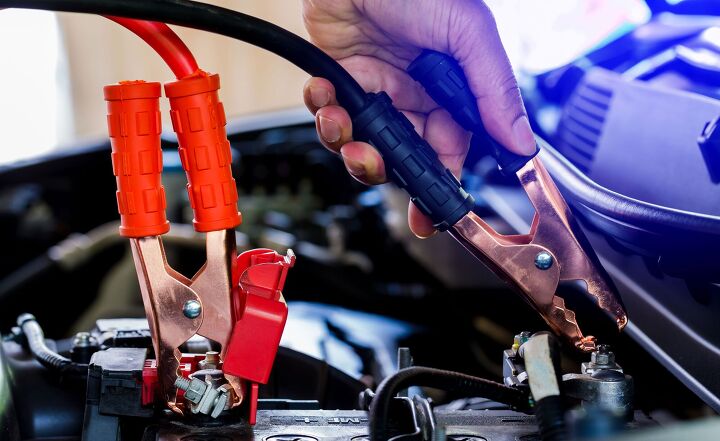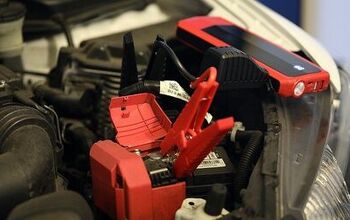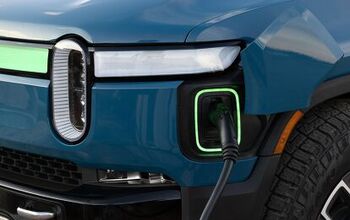How To Jump Start Your Car

It’s a cold, dark night and you’re walking out to your car. You get in, press the start button, and instead of the usual sound of your engine bursting to life you hear nothing. Just a small click comes from the front of your car as dim gauges cast a dull glow onto your distraught face. You need a boost, but do you know how? Here’s what you need to know to jump-start your car, truck, or SUV.
Battery Tester
The first thing you want to do is make sure that the battery is the problem. You can check it like a professional by using a battery tester, but you probably don't keep one of those in your trunk. Instead, listen and look. Do the headlights look much dimmer than usual and come back slowly after you try and start the vehicle? Does the engine turn over sound much slower than you remember? Is there just a click when you turn the key from somewhere deep under the hood? Those are all good signs that you need a jump to get you where you need to go.
Jumper Cables
Fortunately, a jump start is pretty easy, as far as emergency repairs are concerned. You don't need much to do it other than another vehicle with a good battery and a set of jumper cables.
Smart Jumper Cables
Jump starting, or boosting, a vehicle is when you connect the battery from one car to the dead battery in another. The first car's battery gives enough of an electrical boost, or jump, that the car with the low battery can start running and recharge its own battery using the alternator. Common causes of a dead battery this will fix include leaving your lights on, listening to the radio for too long, or sometimes just an old battery.
Start by parking the vehicle with the good battery as close as possible to the engine bay of the one with the dead battery. You'll want to be able to fit between the two vehicles (and they shouldn't touch), but you need them to be close enough for your battery cables to reach across. If you often park in a space where it's tough to get a car close to you, then you might want to buy a longer set of jumper cables that can cross the distance.
Open the hoods of both vehicles and turn off both engines. You don't want to worry about the cables catching in the fan, alternator belt, or any other moving parts. Then you connect your jumper cables, but it's more complicated than just clamping on somewhere.
Look for a large red piece of plastic with a + on it. Many modern vehicles have a special terminal for jump starts that is in an easy-to-reach spot, and that's how they're marked. That's the spot you'll use if your battery is actually in the trunk or under the rear seat, making the jump start easier. If you can't find one, then you're going to use the positive terminal on the battery itself, again usually marked + and colored red. Uncover the terminals on both vehicles.
This part can be easier with a second person, because you need to hold the negative terminals away from bare metal parts on the vehicle until you're ready to connect. Some jumper cables have a built-in safety mechanism that prevents reversing polarisation and that won't let current flow until everything is hooked up. These intelligent jumper cables make the task even easier.
Jump Box
Connect the positive terminal on the live car, then the positive terminal on the dead car, using the two red jumper cable clamps. Make sure that the clamps are securely fastened.
For the negative, or black clamp, there is no special terminal. You also shouldn't use the negative battery terminal because connecting the negative clamp will likely cause sparks. A dead battery can give off hydrogen gas and those sparks could cause a fire. Instead, clamp the negative end of the cable to a bare metal engine component. Usually, there will be a bracket or bolt on the engine you can use. It is ok to use the negative battery terminal on the good battery, if necessary, but it's best to avoid that terminal on the bad battery. And if you don't see at least a few sparks, then you may not have gotten a good negative, or ground, connection. Try another spot.
Connect the live car first and the dead car second. Then make sure the cables are away from any parts that could move, like the fan, and start the engine of the running vehicle.
Let it run for a minute or two, keeping RPM at around 2,000 or so, if possible. Then try and start the car with the dead battery. It may take a few turns, but it should start. If it doesn't, let the car run for a few more minutes. If it still doesn't start, check all of the connections. If they're all secure, your battery may have been damaged by low voltage and won't hold a charge.
Disconnect the cables in the reverse order, negative on the jumped car, negative on the jump car, positive on the jumped car, etc. Don't turn off the engine of the car that was boosted. That car should be taken for a long drive. In a modern vehicle, that means 20 minutes or more. Idling won't give a new vehicle and its complex electrical system enough of a charge.
There is a second, easier way, that doesn't require a second vehicle. You can buy small batteries in a custom-built box, called a jump box, that are designed to be stored in your trunk and let you jump-start your vehicle by yourself. They need to be charged every few months, or once a year if you purchase a smaller and more powerful lithium-ion jump box.
Jump Box Inverter
To start your vehicle using one of these is simple. There are just two connections, both on the vehicle with the dead battery. Connect the positive terminal as above, then connect a bare metal ground. Turn the jump box on, or press its start button, and then try and start your vehicle. It should fire up and get you home.
Whatever reason you need to boost your vehicle, have your battery checked as soon as possible. Car batteries don't work well after having low voltage, so your battery may need to be replaced sooner rather than later, and a diagnostic can fill you in.
Booster cables are simple devices. A pair of insulated wires with a clamp at each end, color-coded so you know which to use, but technology has advanced these making them easier to use than ever. Some features you'll want to look for include
Jump boxes have also come a long way since their introduction. Features you can find on modern jump boxes include built-in battery charging for home use, USB plugs to let you charge your phone dozens of times or run your laptop, 12V power outlets for lighter accessory items, and even 110V outlets to plugin small home electronic devices.
Insulated Gloves
Other nice things to have with your cables include insulated gloves. 12V power from a car battery is much less likely to cause you injury than household electricity, but gloves can give you peace of mind, protection, and clean hands.
Featured Photo by By koonsiri boonnak/Shutterstock
We are committed to finding, researching, and recommending the best products. We earn commissions from purchases you make using the retail links in our product reviews. Learn more about how this works.

Aaron is a freelance writer, videographer and car enthusiast based out of the Detroit area. He has a special affinity for the Porsche 944 series, and once owned a Volvo 240 sedan with a Weber carb in place of the factory EFI system. His work has appeared on AutoGuide, GM Authority, /Drive, and VW Vortex, among other sites.
More by Aaron Brzozowski






































Comments
Join the conversation